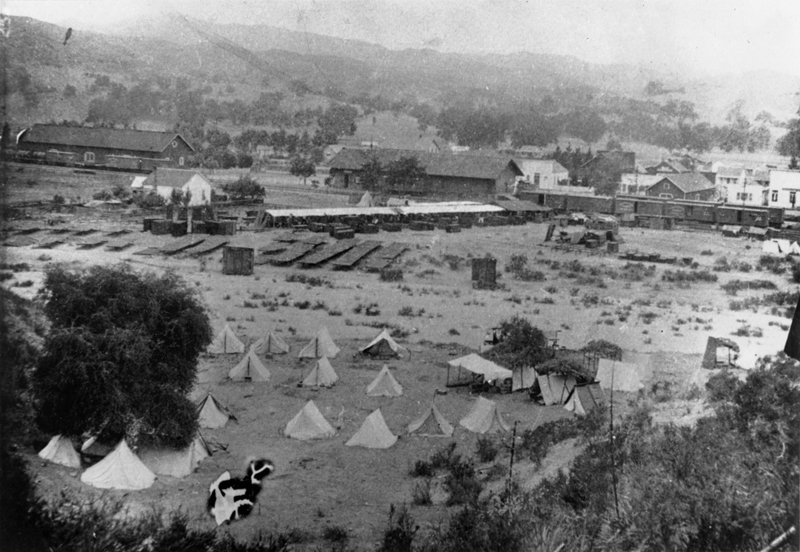|
|
Newhall, California
Commercial fruit drying operation in Newhall in the late 1880s. The view is looking west at Railroad Avenue (Newhall's main street at the time). At left is the so-called potato warehouse, at center is the SPRR Newhall depot (the two buildings look similar); between them in the foreground is the home of John Gifford, the SPRR station agent at Newhall. Today (2013) this area is between the Newhall Metrolink Station (which sits on the site of the old depot) and the ridgeline to the east of it, where the photographer is standing.
A handwritten notation on the back of the photograph by an unidentified person describes this as "The first commerical fruit drying in Calif. / Cutting fruit in Newhall." Another notation in a different hand says, "1885." However, if this is 1885, then the original Southern Hotel should be visibile in the background behind the depot; it isn't. Instead the structure on that location appears to be the second Southern Hotel. Thus this photograph is probably closer to 1888; the first Southern Hotel burned down in 1887.
Maggi Perkins (2010:45) puts it in 1890. She writes: "Growers in Ventura County shipped apricots and plumbs to dry in Newhall's hot, dry air. ... The tents in the foreground housed the mostly Chinese labor force."
According to Maggi's grandfather, historian A.B. Perkins (here), in the 1880s, "the Earl Fruit Company of Los Angeles, Fleming & Fontana of San Francisco and Visalia, and other similar operators, utilized the broad flat east of the tracks for fruit drying. Even after mechanical dehydration had come into use in the dried fruit industry, it was not uncommon for fruit dryers to burn out or be stymied by machinery breakdowns. At those times, Newhall picked up a temporary payroll.
"One of those days when the entire flat was well covered by trays of cut and drying fruit, a 'twister,' similar to the twister that deroofed the local ice plant in 1955, came shooting down the valley. Trays and apricots, trays and apricots, rained heavily for some time.
"At the drying sheds, the cutters were all Chinese. The foremen were Americans and they were instructed by the Chinese Tong leader, acting as Padrone, to fire employees every week or so. The leader got $1.00 per head for furnishing new employees."
AP1012: 9600 dpi jpeg from copy print.
The site owner makes no assertions as to ownership of any original copyrights to digitized images. However, these images are intended for Personal or Research use only. Any other kind of use, including but not limited to commercial or scholarly publication in any medium or format, public exhibition, or use online or in a web site, may be subject to additional restrictions including but not limited to the copyrights held by parties other than the site owner. USERS ARE SOLELY RESPONSIBLE for determining the existence of such rights and for obtaining any permissions and/or paying associated fees necessary for the proposed use.
